Backed by SEO research and experience, this e-commerce SEO checklist gives you a clear framework to boost rankings, improve site structure, and convert more visitors, whether you're running a niche shop or a large-scale store.
Updated on
November 19, 2025
| Maria Harutyunyan, Head of SEO

48

48
E-commerce SEO Checklist
Download the checklist

The checklist is vetted by 3 more top SEO LinkedIn experts
E-commerce Keyword Research


Copy selected rows
Create a Website Architecture


Copy selected rows
Optimize On-Page SEO


Copy selected rows
E-commerce Technical SEO


Copy selected rows
Product and Category Page Management


Copy selected rows
User Experience & Conversion Optimization


Copy selected rows
Off-Site SEO for E-commerce


Copy selected rows
E-commerce Content Marketing


Copy selected rows
Local SEO for E-commerce


Copy selected rows
E-commerce Analytics & Performance Monitoring


Copy selected rows
In 2025, 60% of shoppers buy online, and one in three starts with a simple search. That means your visibility at every step, from discovery to checkout, matters more than ever.
A strong eCommerce SEO strategy isn’t optional; it’s what turns browsers into buyers. After helping 210+ eCommerce brands grow their traffic and sales, I’ve learned exactly what works.
This guide walks you through every step, and at the end, you’ll get a downloadable 48-point checklist covering everything from technical SEO to on-page tactics and backlinks.
Let’s dive in and build an SEO foundation that drives sales.
For a new website, start from scratch: list your products, category pages, and blog ideas, then find accurate keywords for each.
For an established website, review your current keyword strategy and compare it with what people are actually searching for.
Here’s how to do keyword research like a real eCommerce SEO expert:
As an eCommerce brand, you already know how to describe your products and who they’re for. That same understanding helps you identify SEO keyword intent, the real reason behind a user’s search.
Search intent (also called SEO intent or keyword intent) is the purpose behind a search query. Let’s look at a real-world example.
Imagine you run an eco-friendly baby dinnerware store. Here’s how search intent breaks down:
Understanding these types helps you avoid a common mistake: mixing intents.
Remember the golden rule: one keyword intent = one URL.
For example, if you write a blog post titled “How to Use Baby-Led Weaning Spoons,” it won’t rank for “baby-led weaning spoons.” That’s a transactional keyword suited for a category page, not an article.
Even within transactional searches, intent can vary:
Confused? That’s fine. Sometimes, even experienced SEOs can’t tell intent just by looking.
In those cases, analyze the search engine results pages (SERPs) to see what type of content Google is rewarding.
You can analyze the SERPs manually or with SEO tools.
Start simple: type your keyword into Google and review the top 10 results. Look at the type of pages that rank.
If category pages dominate, you’ll have a better chance by targeting that keyword with your own category page, not a product page.
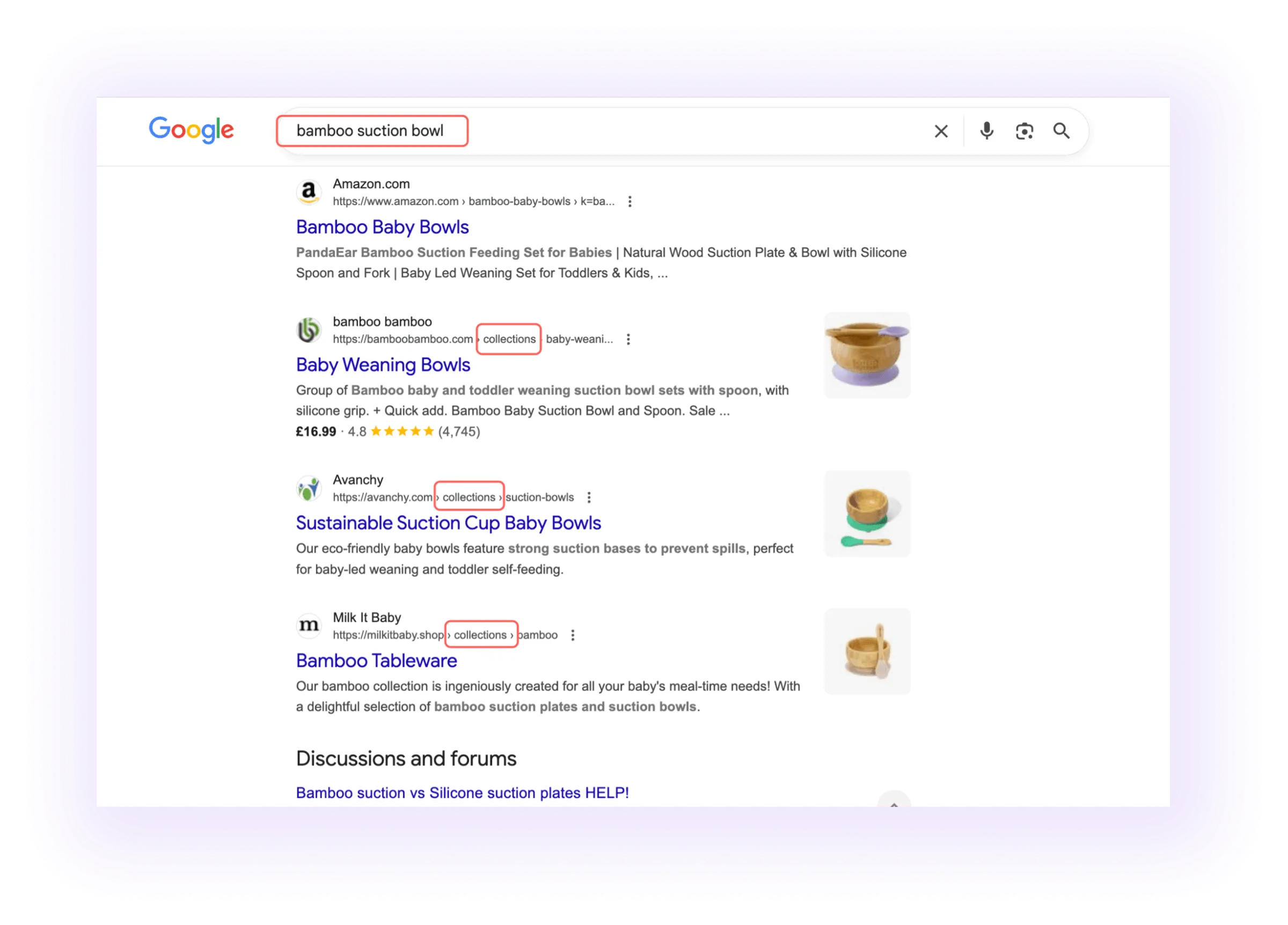
For deeper insights, use specialized tools like Ahrefs, which show you valuable metrics, including:
Then use the Keyword Explorer feature to evaluate whether a keyword is worth pursuing and how strong your competitors are.
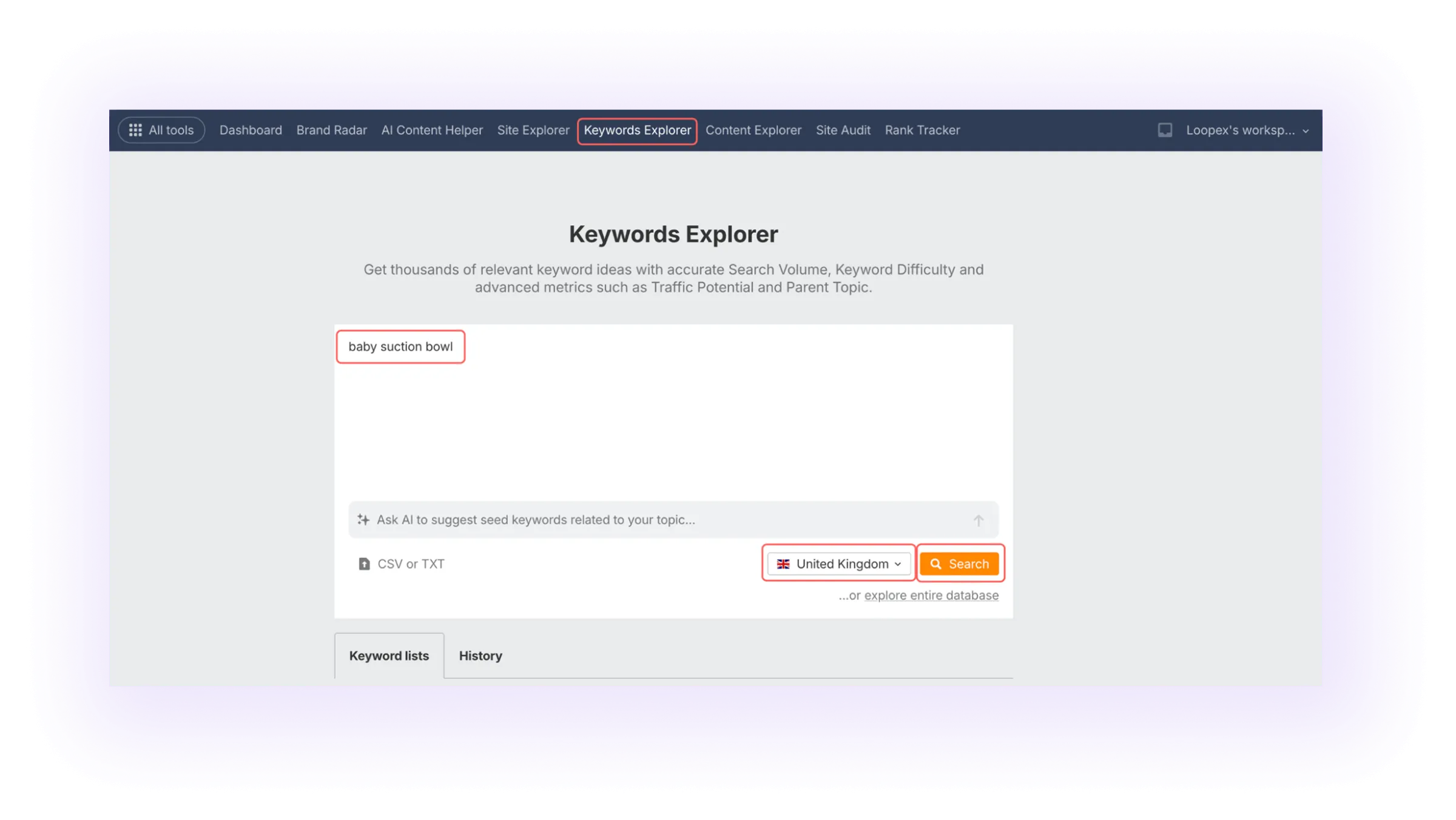
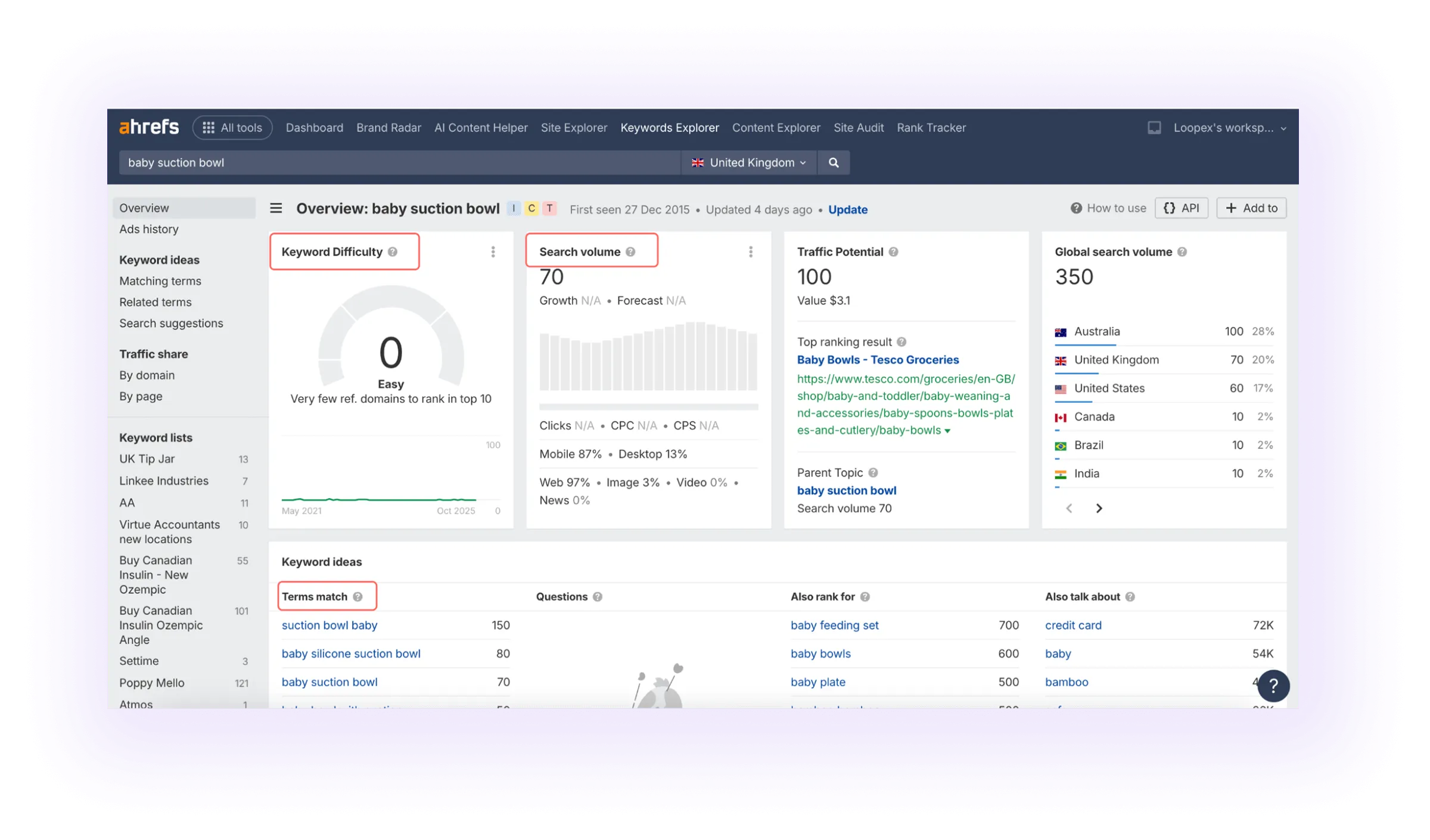
When you scroll down, you’ll also see other websites that are competing for the keyword.
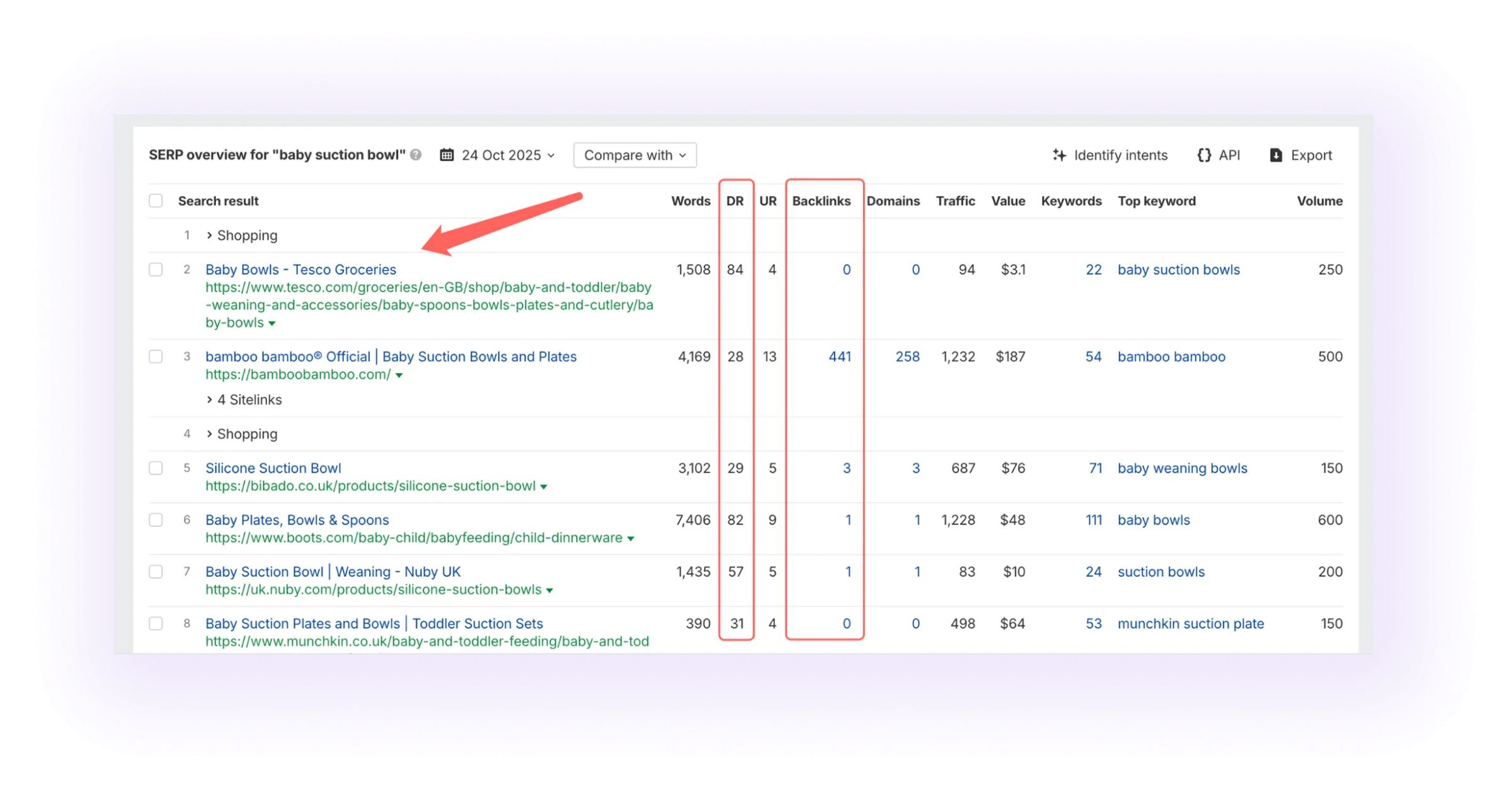
Repeat the same research steps for every keyword you’re considering.
Prioritize category keywords first. They usually have higher search volume and stronger traffic potential.
For example, if you run an online stationery store selling planners, notebooks, journals, and gifts, your category keywords might include:
Using Ahrefs’s Keyword List feature, you could name your list “Stationery Category Keywords.”
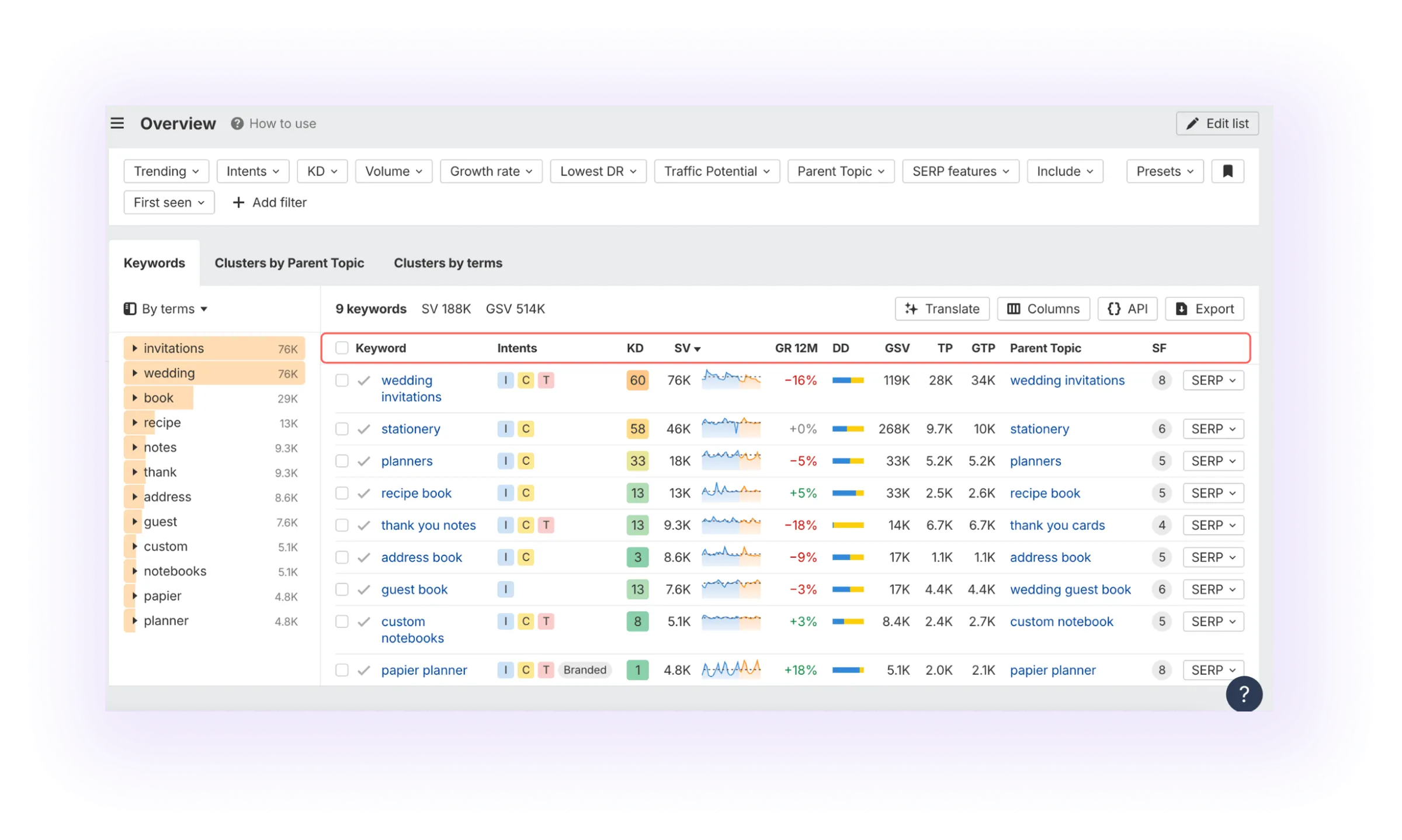
You can learn how to create keyword lists in Ahrefs here.
Or, simply collect your keywords in a Google Sheet and add their metrics manually.
The goal is to keep your keywords organized for future SEO planning under sections like:
Enter a successful competitor’s domain into the Site Explorer to see which keywords they rank for, and add the most relevant ones to your list.
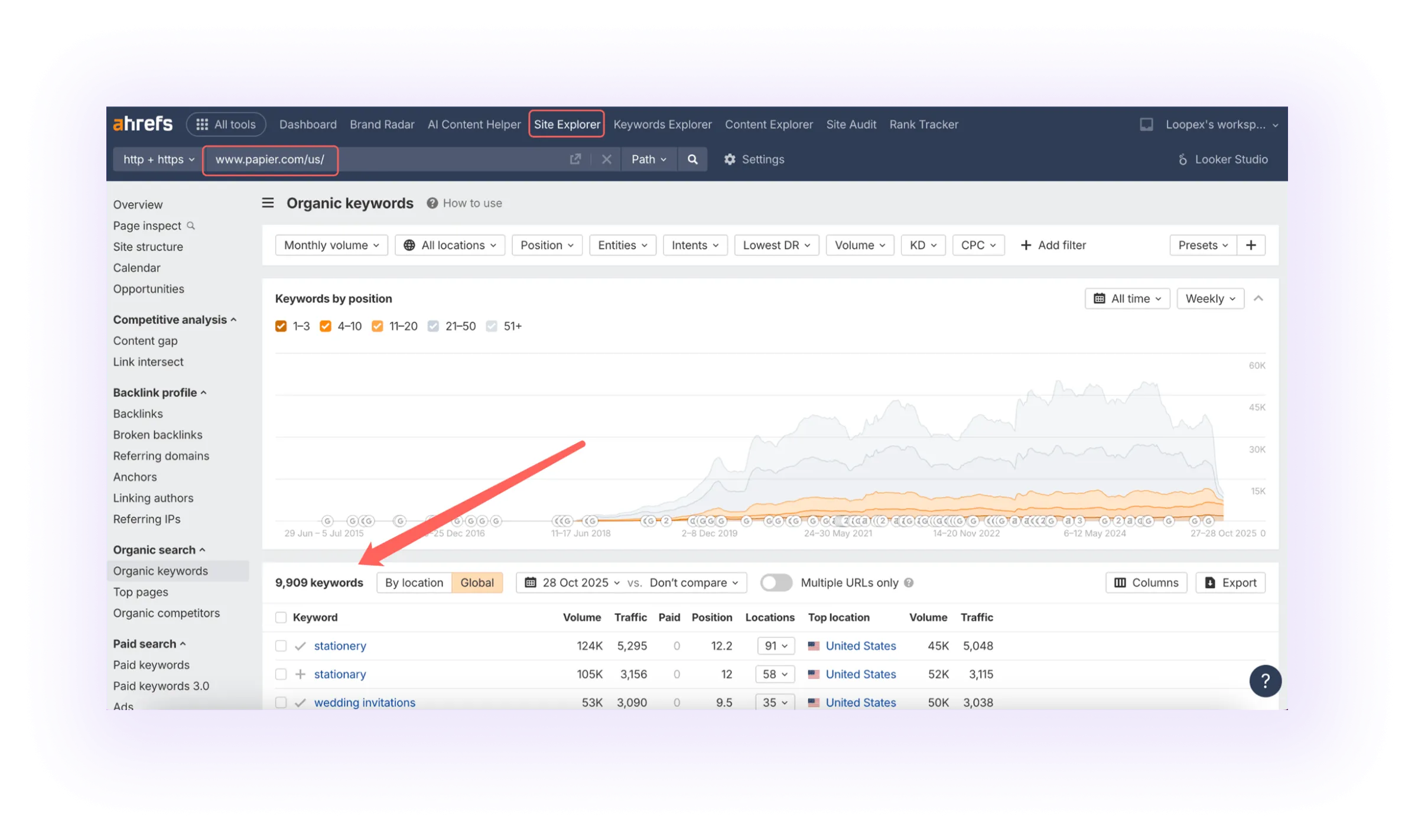
Filter by position and keyword difficulty to find the easiest opportunities, and see which keywords your competitors rank for in the top 10 results.
For a faster approach, run a Content Gap Analysis in Ahrefs to find keywords your site is missing.
Look for descriptive keywords that show different search intents within the same product category.
You don’t have to stick to a single URL for your journal collection. Think about organizing your products into related categories that match how people actually search.
Shoppers look for different qualities in journals: some by color, some by theme, even by cuteness level, gender, or material. Examples:
Each of these keywords gets around 1,000-2,000 monthly searches in the U.S.
Don’t miss potential customers searching for something specific just because you only created one general page.
Building semantic clusters is far more effective than simply adding keywords at random.
Imagine you’re planning a blog strategy for your stationery shop. Pick one category you want to strengthen and focus only on keywords related to that topic.
For example, if you want to boost your “Bullet Journals” category, your supporting blog keywords might include:
This focused approach keeps your SEO efforts consistent and builds a stronger topical foundation around your main category.
Your website’s architecture depends on the categories, products, and blog content you plan to include.
The previous section helped you decide what to build; now it’s time to focus on how to organize it so both users and Google can easily navigate and understand your site.
There are two main types of URL structure: flat and hierarchical.
The best choice depends on your shop’s size, growth goals, and platform.
Flat Structure
A flat URL structure keeps all pages on the same level, with no folders or subfolders:
It’s ideal for small to mid-sized stores with a limited product range.
Flat structures also work best for platforms like Shopify, Squarespace, and Wix.
The advantages are the simple setup, faster crawling by search engines, and easier management.
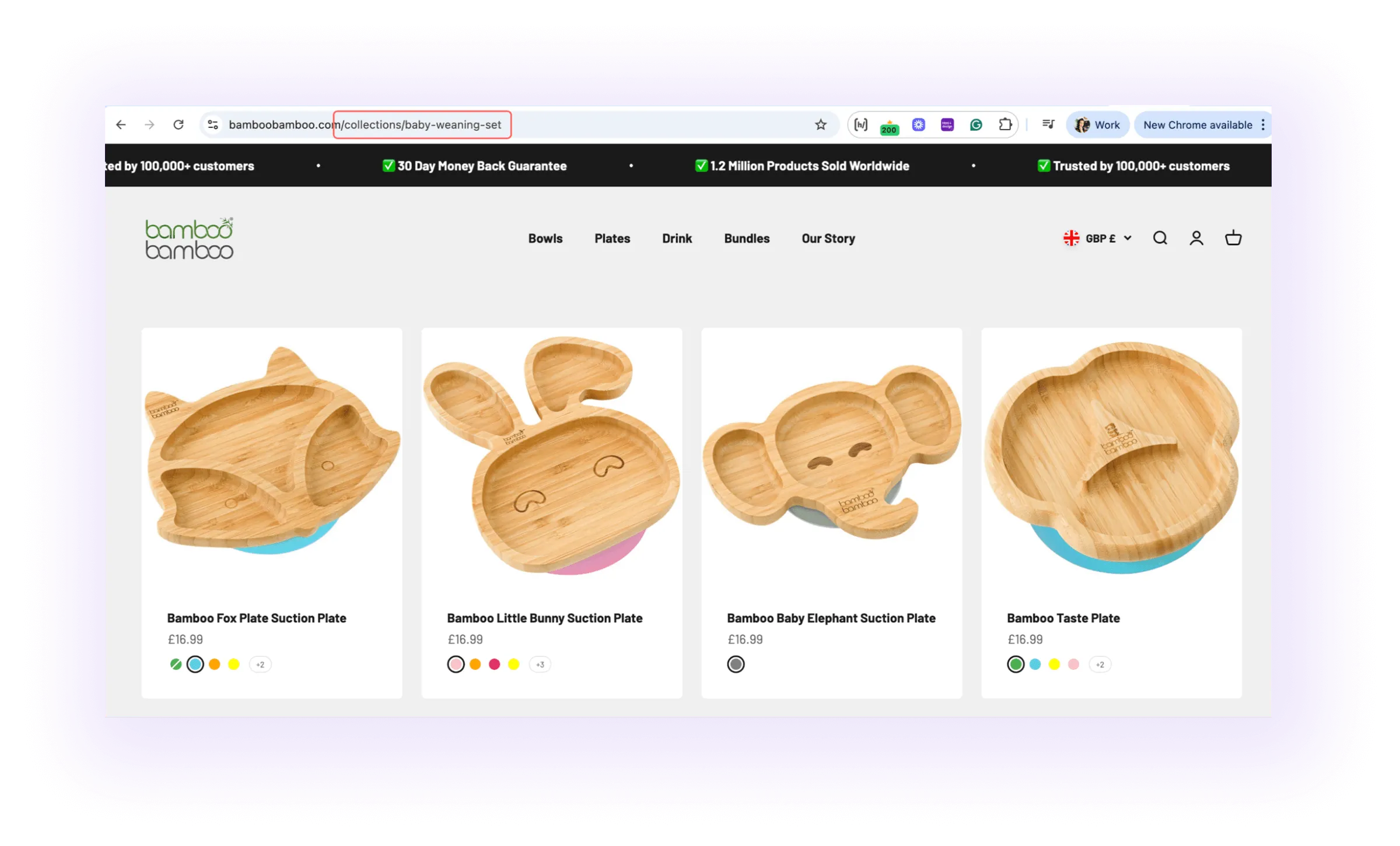
Hierarchical Structure
A hierarchical URL structure organizes content into levels with main and subcategories:
This structure supports scalability and logical organization, making it perfect for mid- to large-scale eCommerce sites.
Platforms like Magento and WooCommerce handle it well, while enterprise sites often use custom setups.
The drawbacks are that deeper URLs can be harder to discover, but this risk is easily reduced with strong internal linking.

As mentioned, internal linking is essential for both hierarchical and flat websites. It helps you:
For eCommerce websites, focus on these key internal linking steps:
Step 1: Link collection pages to other relevant collection pages.

Step 2: Link product pages to related products.

Step 3: Link to the necessary money and informational pages from the menu.

Step 4: Connect informational content pages to other pages within the same topic group.

Step 5: Use breadcrumb links to show relationships between categories, products, and even guides.

Step 6: Add footer links to important pages for easy access.

A sitemap lists every page on your website. The sitemap.xml file helps search engines find and index them quickly.
For eCommerce stores, this means your products, categories, and blog posts stay visible to Google. You can also include images, videos, and other key pages to give search engines a complete picture of your site.
A clear sitemap helps bots crawl your site faster and improves your SEO visibility. It also makes it easier for customers to find what they’re looking for.
Sitemaps can vary by platform; just make yours as clean and organized as possible.
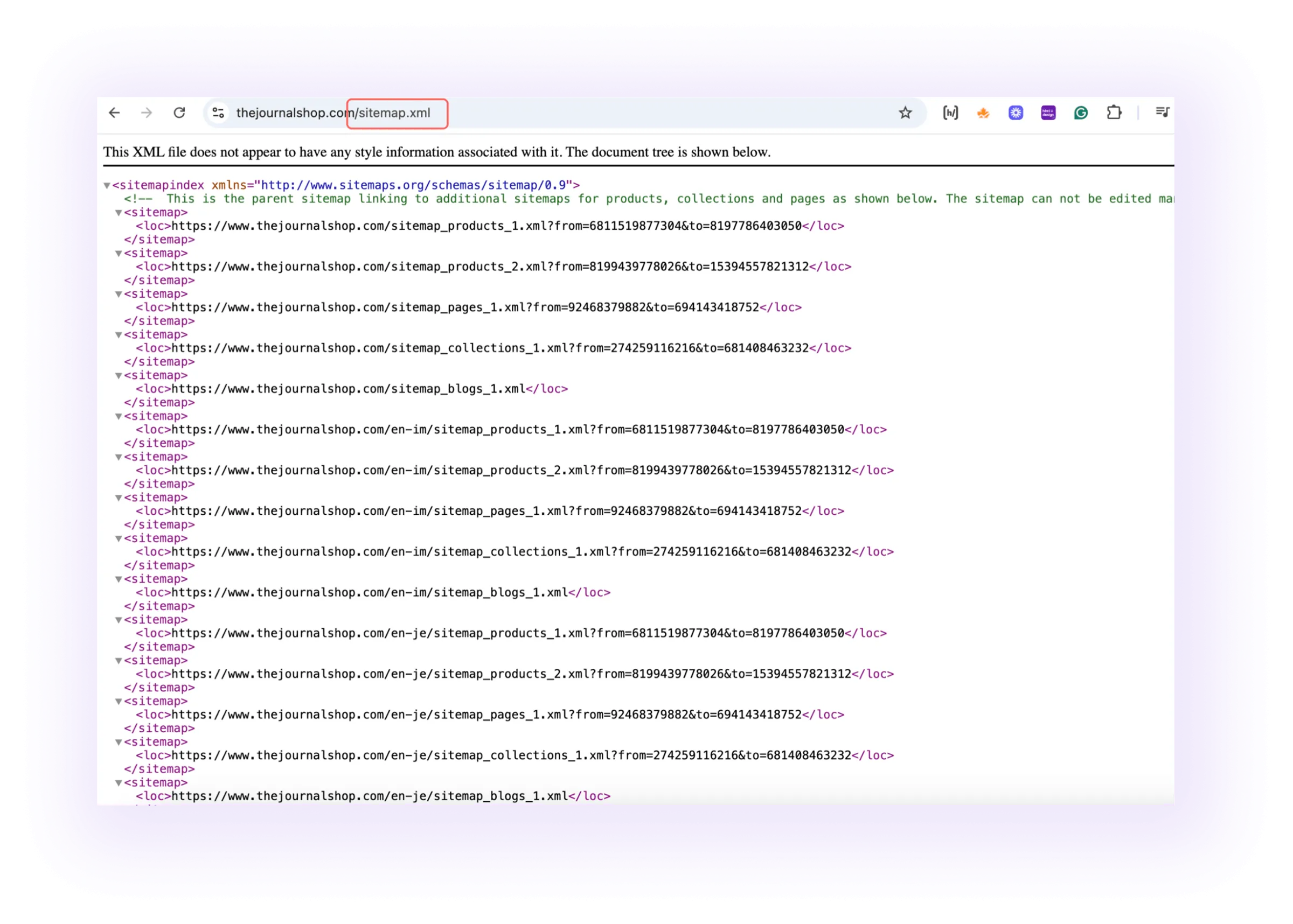
Simply put, technical SEO makes sure your eCommerce website can be crawled, indexed, and ranked by search engines.
Below are the most critical technical SEO elements to focus on, especially if you’re short on time and want to cover what truly matters.
For your pages to rank, Google must first crawl and index them. Without indexing, even the best product pages won’t appear in search results.
Check the following points to ensure your site is fully crawlable and indexable:
To identify and fix crawlability or indexability issues, review the Indexing report in Google Search Console.

Around 71% of Google searches happen on mobile devices, making mobile usability a top priority. Do it this way:

Schema markup is code added to a website’s head section to help Google understand the content of each page.
It can also help your site appear in Google’s rich results, thereby significantly improving click-through rates (CTR).
For eCommerce, rich results are especially valuable because they boost visibility and engagement.
Details like prices, ratings, and images are the attributes that make rich results so powerful. See the example snippet below.

But Schema Markup isn’t just about rich results.
Depending on your eCommerce setup, you may need different schema types:
To explore more schema types suited to your store, visit the Schema.org Validator.
Website speed for eCommerce depends on fast loading times, mobile optimization, and clean site organization.
Core Web Vitals are the key metrics here. They measure how quickly a page loads, how stable it is, and how responsive it feels.
A quick, user-friendly site with solid Core Web Vitals helps both users and search engines access your content easily, which can improve rankings.
Proper image sizes, clean code, and reliable server performance also play a big part in keeping your site fast.
For example, I checked the Core Web Vitals performance of the journal shop we’re analyzing using Google’s free PageSpeed Insights tool. The results show excellent scores for both mobile and desktop.

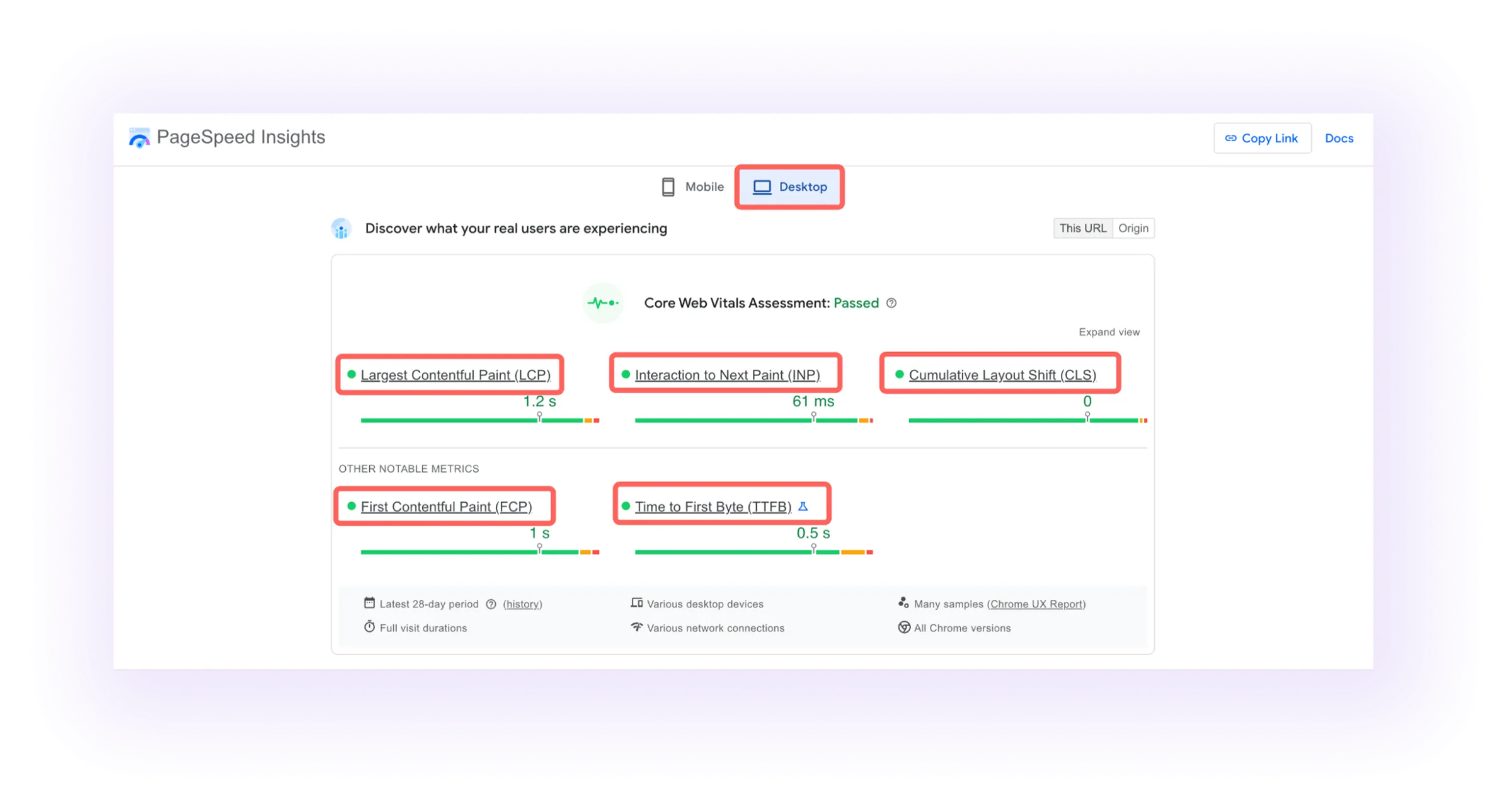
Here are the Core Web Vitals metrics to strive for as an eCommerce:
To achieve this, you need to focus on optimizing images, minifying CSS/JS files, improving server response time, using efficient formats, and more.
In SEO, duplication means having identical or very similar content or URLs appearing in multiple places on your website.
On eCommerce sites, duplication often occurs at the URL level and is usually caused by three factors.
When product lists are split across multiple pages, it can create duplicate content and similar URLs that confuse search engines.

Solution 1: Set the main page as the canonical for all paginated pages. This tells Google they’re part of the same series, not separate duplicates.
Solution 2: Use infinite scrolling to load more products as users scroll, helping reduce duplicate paginated URLs.
Product variants can create duplicate URLs when similar versions, such as different sizes or colors, each generate their own URL.
Solution: Use canonical tags to point all variant URLs to the main product page.
Duplication can occur when similar content appears across regional versions of your site.
For example, /en-ca/ and /en-us/ might display nearly identical pages for Canada and the U.S.
Solution: Add hreflang tags to indicate the correct language and country version to Google, preventing duplicate regional pages.

Before we get into content and on-page optimizations for different page types, let’s quickly cover one of SEO’s most essential concepts in recent years: E-E-A-T.
E-E-A-T stands for Expertise, Experience, Authority, and Trustworthiness.
It’s Google’s framework for distinguishing a credible website from a low-trust one.
Here are a few eCommerce-friendly ways to build and signal trust:
Category page content should always be written with the buyer’s experience in mind.
Think about what your customers want to know before making a purchase.
Imagine someone walks into your store looking for a bullet journal from your collection. They’re not asking, “What is a bullet journal?”
They want to know what kinds you have, what makes them different, and why they’re worth buying.
That’s exactly what your collection page content should do: not define, but sell.
Here’s how to make your collection page content more valuable:
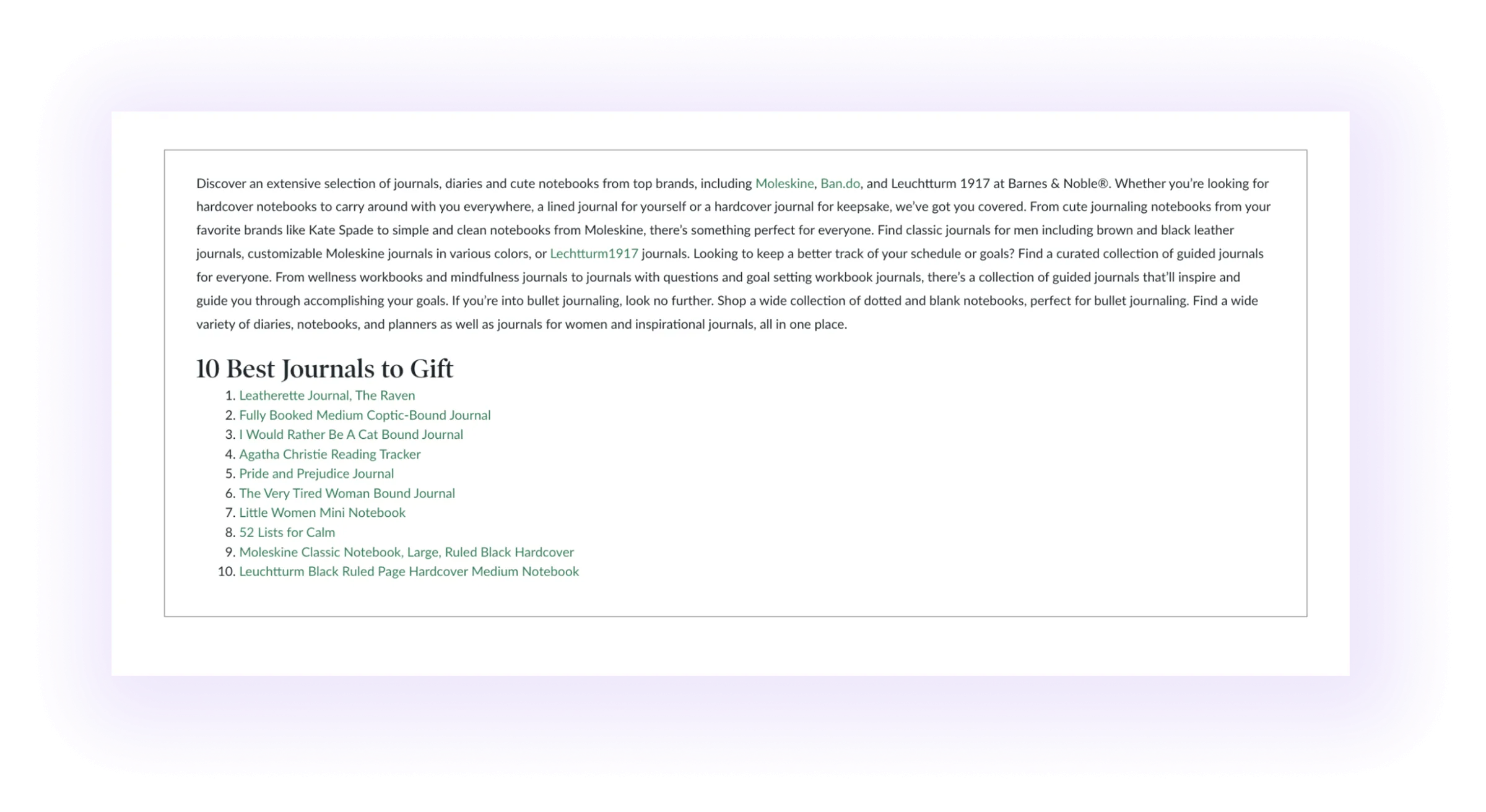
Once you’ve done that, use tools like Google’s People Also Ask or Ahrefs’ Keyword Explorer’s Questions section.
These tools show what genuine buyers are searching for; include those answers naturally in your content.
Once your category page content is set, it’s time to optimize the page for search visibility and usability. Here’s what to focus on:

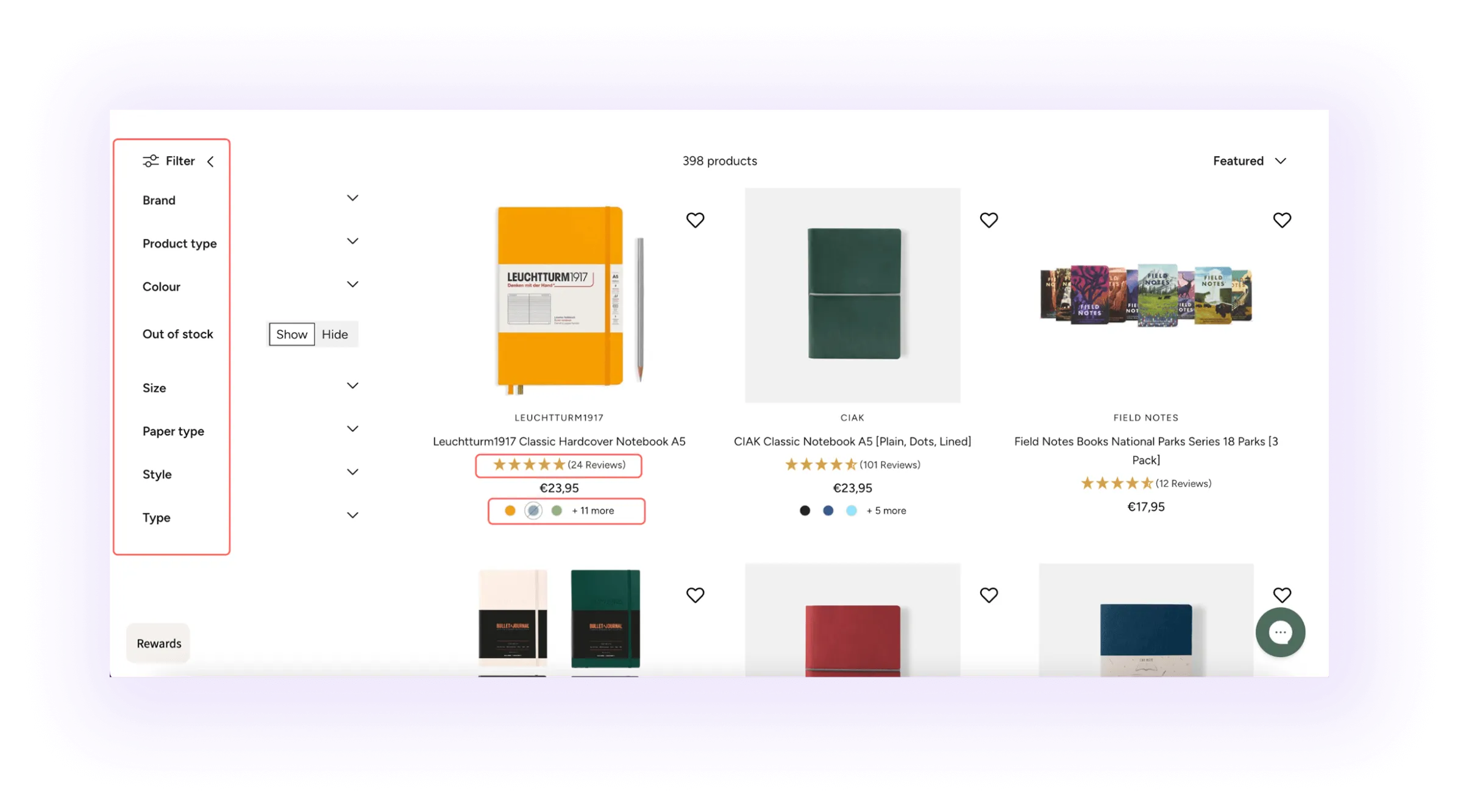
Product page content usually includes a detailed description, product specifics, and shipping information.
To make it effective, describe the product as accurately and thoroughly as possible:

Your descriptions and details are ready. Now, let’s fine-tune the page for search visibility and performance:
In 2025, top-ranking informational content is miles ahead of even 2023 standards across every niche.
I see it daily when evaluating client content against what’s ranking in the SERPs.
If you take one thing from this section, make it this:
Skip Wikipedia-style explanations. Focus on answering fundamental questions with practical steps, specific examples, and firsthand insights.
Give readers what AI can’t: experience, depth, and genuine expertise.
Here’s what defines high-quality informational content today:
Once your content delivers real value, it’s time to make sure Google recognizes it, too:


Let’s look at the most effective eCommerce link-building strategies my team used successfully in 2025.
Guest posts involve writing helpful, relevant content for other websites in your niche and including a link back to your own.
For example, you could publish an article titled “Top Trends in Bullet Journals” on a popular stationery blog and link naturally to your bullet journal collection or product page.
Digital PR focuses on creating newsworthy stories in your niche that journalists and publishers want to share.
For example, you could run a study or experiment on baby weaning bowls and share the results. This type of content attracts backlinks from reputable, hard-to-reach publications.
Product reviews and roundups help you get featured in curated lists or reviewed by influencers in your niche.
For example, your “Cute Journals” collection could appear in a “Best Journals for 2025” roundup. These backlinks not only strengthen your SEO but also build trust with potential buyers.
Here’s an example of an influencer’s review of a well-known bullet notebook.

Link building for AI overviews works much like roundup link building but focuses on earning placement in Google’s AI Overviews or featured snippets.
Your goal is to be listed among the trusted sources that appear in these summaries.
For example, getting featured in “The Best Notebooks for Journaling in 2025” by TheCasualReader, as shown in the screenshot below.
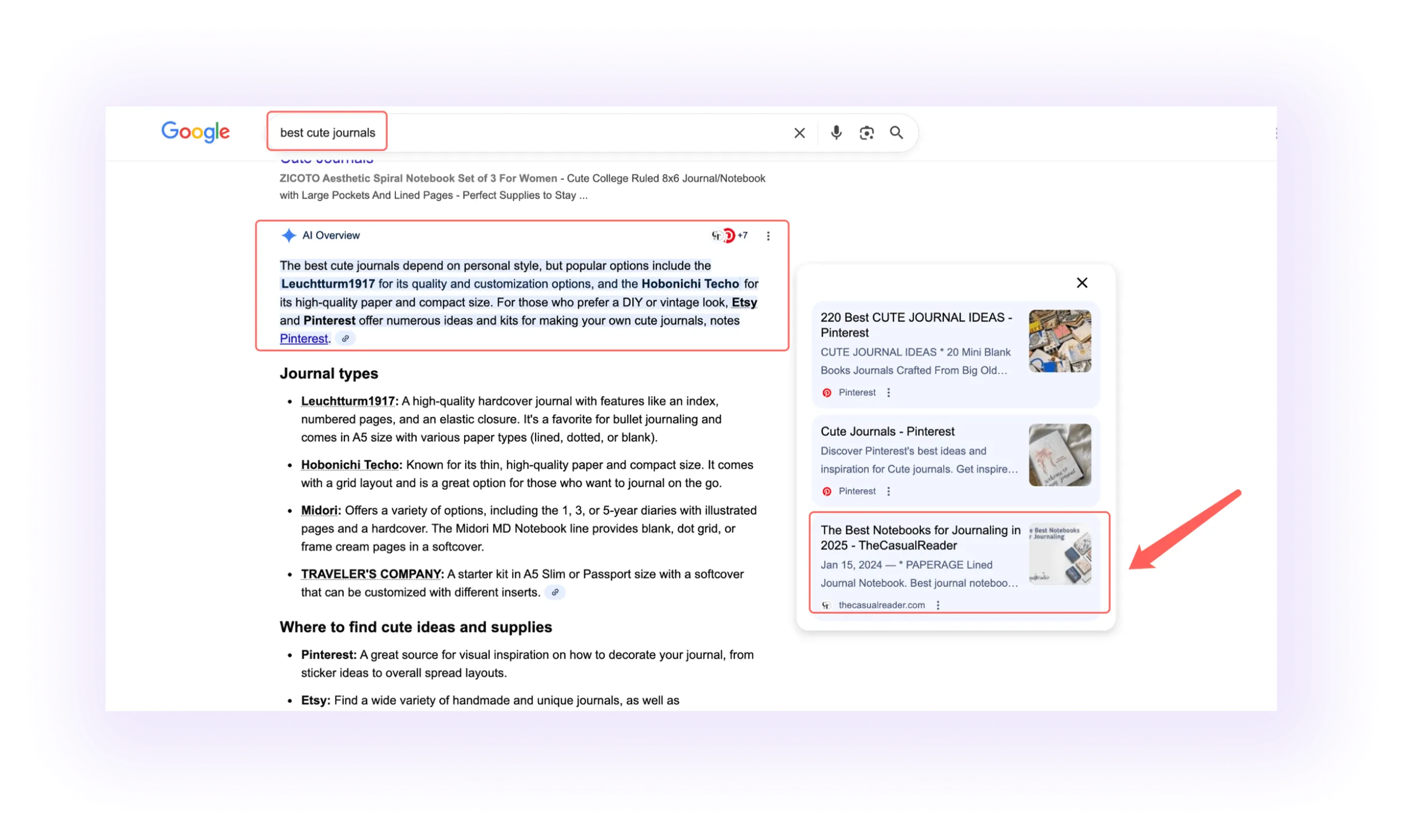
To find the right websites for outreach, you need a reliable prospecting tool to vet potential partners and choose the best ones.
Linkee.ai is an AI-powered tool that streamlines this process by automatically filtering prospects based on contextual relevance and Domain Rating, while excluding insecure sites, spam, and private blog networks (PBNs).
It also automates outreach, making it much easier to secure high-quality backlinks without the manual work.
For eCommerce businesses serving a specific area, the strategies above still apply, but there are a few local-specific steps to take.
Start by setting up and fully optimizing your Google My Business profile. Add accurate details such as your business name, address, phone number, website, hours, and high-quality photos.

This helps you appear in local search results, especially for location-based queries like “buy bullet journals in [city].”
In addition to Google My Business, list your store in reputable local directories such as Yelp or your local Chamber of Commerce.
Make sure these directories are either specific to your area or relevant to your niche.
For eCommerce sites, here’s what’s important to monitor:
Here’s what tracked keywords on Ahrefs look like:
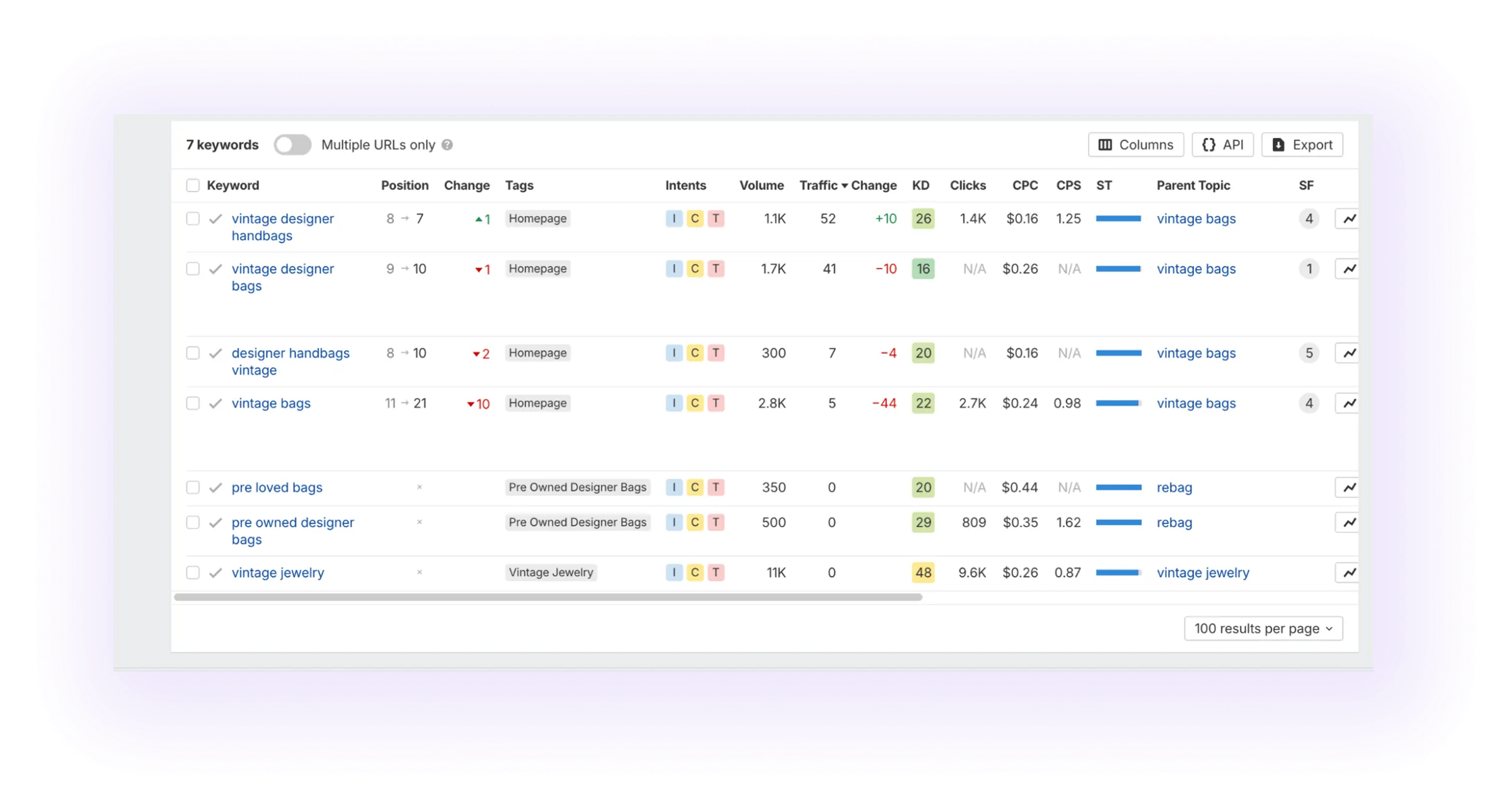
Other metrics to pay attention to are:
The takeaway is not to guess and use these tools for better tracking:
DIY eCommerce SEO can feel overwhelming, but we make it simple and deliver real results.
At Loopex Digital, my team and I help eCommerce brands boost traffic and sales through proven, data-driven SEO strategies.
Our clients have seen significant gains in organic visibility and keyword rankings, enabling them to focus on growing their businesses while we handle SEO.
Join 210+ other eCommerce businesses for dramatic growth in eCommerce SEO!
Submit the form - Get Free Proposal
%202.png)
24 hours
Submit the form - Get Free Proposal
%202.png)
24 hours

A well-structured approach is the cornerstone of successful SEO. That's why we’ve developed a series of in-depth checklists designed to streamline your SEO strategy. From building high-quality backlinks and optimizing your WordPress site to tackling on-page SEO and technical optimizations, our checklists offer precise, actionable steps to help you confidently navigate every aspect of SEO.
April 3, 2025